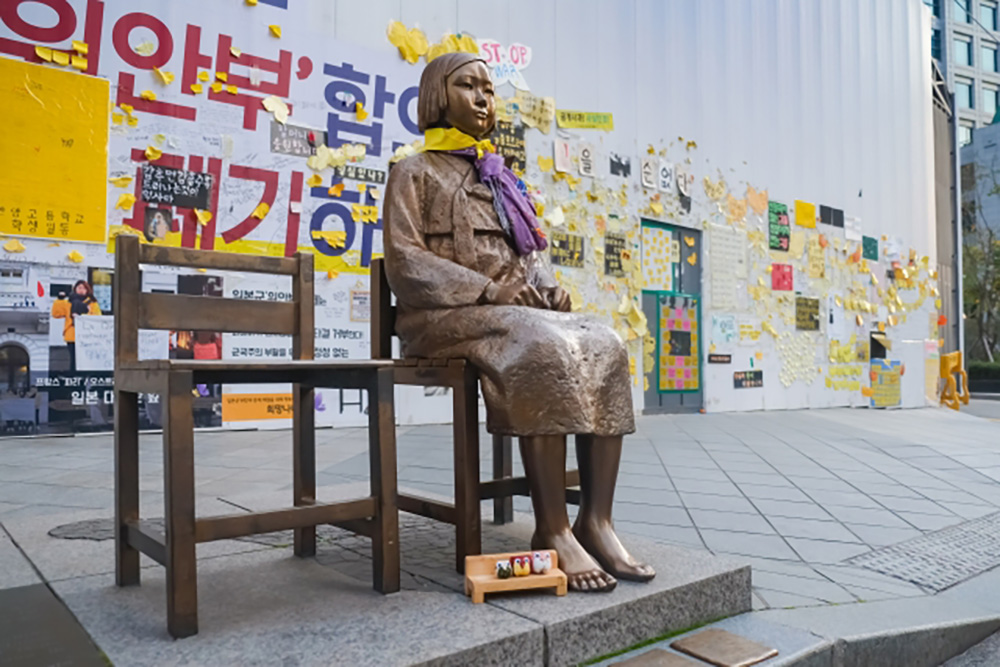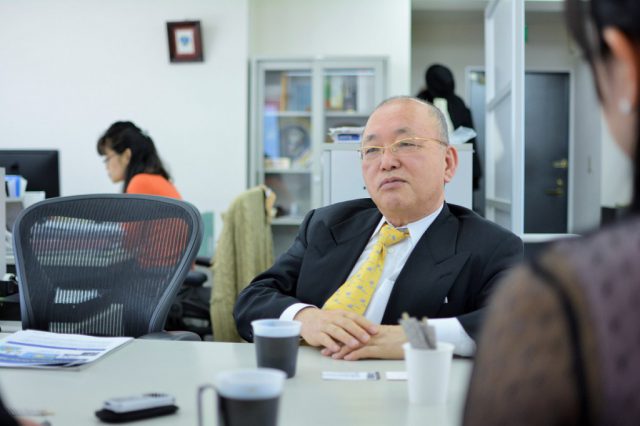◆文:海野恵一(元アクセンチュア 代表取締役)
 (写真=写真AC)
(写真=写真AC)
本稿は、慰安婦問題が戦後70数年たっても、未だ日韓の大きな課題の一つになっている現状に対して、
残念ながら、英語のまとまった資料が今までないということで、海野塾がこの課題を取り上げ、網羅的に英語の資料をまとめ、日本語の解説を付けたものである。
前編はこちら「大東亜戦争における慰安婦問題に日本人は英語でどう答えるのか?」
資料は右とか左の資料も入っているが、ニュートラルな立場で、解説を加えた。
全文は、著書『
How to explain Comfort Woman for the Japanese Imperial army at WWll』を読めば海外の人に、慰安婦の問題を網羅的に解説することができる。
いつまでも、日本軍がしてきたことを曖昧にしたままに放置しておくべきではない。
Japanese Occupation in Korea
慰安婦の話を始める前に日本の韓国併合の時代から説明する必要がある。韓国人の日本に対する考えの背景を理解する必要があるからである。
以下の文章はその時代の日本の統治時代の概略を書いたものである。日本語のその時代の解説を後段に示しているが、内容は大きく異なる。その当時、日本に対して韓国人はいい印象は持っていなかったと書いてある。
この資料全体を通じて、意識しているのは、何が正しくて、何が間違えているのかはわからないということだ。日本人が日本語で理解していることと外国人が英語で理解していることがどう違っているのかも知っておく必要がある。
そのため、日本語の資料をもとに外国人に説明しても理解してもらえない。まずは彼らの外国人の理解を前提に話を進めていかないと最初からボタンの掛け違いが起こってしまい、話が噛み合わないということになってしまう。
本書はすべてインターネットから借用してきたものだが、日本語があるものについてはできるだけ日本語の資料を添付している。逐次、英語と日本語の内容の違いは指摘している。
本書の目的は外国人がこの問題をどう理解しているのか。どこにバイアスがあるのか。我々はこの問題をどう理解するべきか。どのように外国人にこの問題について意見をいうべきなのか。
どう答えていくべきなのか。そういったことに対して、出来得る限りの情報を網羅してきたつもりである。
「日本統治時代の朝鮮」の英語と日本語の内容が異なる。双方とも似たような内容の箇所の抜粋だが、内容が大部異なる。日本語の方は朝鮮の日本の占領によって、朝鮮が良くなったとか、朝鮮人が親日になったとかの文言があるが、英文にはない。
どっちが正しいのか判断できないが、少なくとも、欧米人と日本人との戦前の朝鮮占領時代の認識は異なる。そもそも慰安婦の議論はここら辺のところからもうすでに、ずれてしまっているように思う。日本の報道も同じようなところがあって、大本営発表的な要素が強い。
英文のウィキペディアから抜粋
Korea under Japanese rule began with the end of the Joseon dynastic monarchy in Korea in 1910 and ended at the conclusion of World War II in 1945. Japanese rule of Korea was the outcome of a process that began with the Japan–Korea Treaty of 1876, whereby a complex coalition of Meiji government, military, and business officials sought to integrate Korea both politically and economically into the Empire of Japan. A major stepping-stone towards Japanese occupation of Korea was the Japan–Korea Treaty of 1905, in which the then-Empire of Korea was declared a protectorate (保護国) of Japan. The annexation of Korea by Japan was set up in the Japan–Korea Treaty of 1910, which was never actually signed by the Korean regent (摂政), Gojong (高宗 朝鮮王).
Imperial Japanese rule over Korea ended in 1945, when American and Soviet forces captured the peninsula. In 1965 the unequal treaties between Joseon-ruled Korea and Imperial Japan, especially those of 1905 and 1910, were declared “already null and void (無効な)” at the time of their promulgation (公布) (i.e. “dead on arrival”, implicitly (無条件に) a declaration of their illegality) by the Treaty on Basic Relations between Japan and South Korea.
当時、日韓併合そのものを朝鮮の王が認めていなかった。また、1965年には韓国政府が1905年と1910年の不平等条約を無効だと宣言した。
Japanese administration of the Korean Peninsula was directed through the General Government (朝鮮総督府). After the Japanese withdrawal from the Korean Peninsula followed by the Japanese surrender to Allied forces at the end of the Second World War, Korea returned to self-government, albeit (だけれども) under two separate governments and economic systems backed (in the north) by the USSR and (in the south) by the United States.
The industrialization of the Korean Peninsula began with the Joseon dynasty (in particular with King, and later Emperor, Gojong) while Korea was still independent, but accelerated under Japanese occupation. It continues to be the subject of controversy (論争) between the two Koreas and Japan. The manner of the acceleration of industrialization under Japanese occupation, especially utilization of industrialization only for the purposes of benefiting Japan, the exploitation (搾取) of the Korean people in their own country, the marginalization (主流からはずすこと) of Korean history and culture, the environmental exploitation of the Korean Peninsula, and its long-term negative repercussions (悪影響) for modern-day North and South Korea are among the most provocative (物議をかもす) aspects of the controversy.
日本が工業化を加速させたかもしれないが、それは日本人のためであって、韓国人のためではなかったと書いてある。
Pre-World War II (1910–41)
Japanese migration and land ownership
From around the time of the First Sino-Japanese War, Japanese merchants had been settling in towns and cities in Korea seeking economic opportunity. By 1910, the number of Japanese settlers in Korea reached over 170,000, creating the largest overseas Japanese community in the world at the time. The Japanese leadership’s conviction (自信) that their country was overcrowded – especially in rural areas – led to encouraging farmers to emigrate.
この1910年当時、朝鮮の人口は1300万人であったが、日本人が17万人以上いたということはすでに、農地に対しての搾取が始まっていたといえる。
Many Japanese settlers were interested in acquiring agricultural land in Korea even before Japanese land ownership was officially legalized in 1906. Governor-General Terauchi Masatake facilitated settlement through land reform, which initially proved (であることをはっきり示す) popular with most of the Korean population. The Korean land ownership system was a system of absentee landlords (不在地主), only partial owner-tenants (借地人) and cultivators (農民) with traditional (but no legal proof of) ownership. Terauchi’s new Land Survey Bureau conducted cadastral surveys (地籍調査) that reestablished ownership by basis of written proof (deeds (不動産の譲渡証書), titles, and similar documents). Ownership was denied to those who could not provide such written documentation; these turned out to be mostly high-class and impartial (公平な) owners who had only traditional verbal(言葉の上だけの) cultivator rights. Japanese landlords included both individuals and corporations such as the Oriental Development Company. Many former Korean landowners, as well as agricultural workers, became tenant farmers, having lost their entitlements (権利) almost overnight.
韓国の教科書に書いてあることをそのまま引用している。こうした文章を読んでいる欧米人は朝鮮総督府がひどいことをしたというイメージを持つだろう。
日本の占領政策で、土地収用のシステムが以前はその所有権が曖昧だったので、朝鮮の人たちから従前の暗黙の権利を取り上げて、新たに日本人にその土地の所有権を設けたことは朝鮮人の根深い日本人に対する敵意を植え付けたといえる。よく韓国人が日韓併合を日本の植民地支配だというのはこういった事ことがあったからではないだろうか。
一方で、コメの生産高は併合当時は1000万石程度であったのが、1940年には2200万石を超えるまでになったということを理解しておく必要がある。1910年は1312万人だった人口が1944年には2512万人に増えている。
By 1910, an estimated 7 to 8% of all arable land was under Japanese control. This ratio increased steadily; during the years 1916, 1920, and 1932, the ratio of Japanese land ownership increased from 36.8 to 39.8 to 52.7%. The level of tenancy (借地権) was similar to that of farmers in Japan itself; however, in Korea, the landowners were mostly Japanese, while the tenants were all Koreans. As was often the case in Japan itself, tenants were forced to pay over half their crop as rent, forcing many to send wives and daughters into factories or prostitution so they could pay taxes.
そのため、農民は半分の収穫を日本人の地主に上納しなくてはならず、妻や娘を工場や売春宿に出さざるを得なかった。そうしなければ税金が払えなかった。慰安婦の話の根底には日本の農村と同じように、こうしたことがあった。
Ironically, by the 1930s, the growth of the urban economy and the exodus of farmers to the cities had gradually weakened the hold of the landlords (地主). With the growth of the wartime economy, the government recognized landlordism as an impediment (障害) to increased agricultural productivity, and took steps to increase control over the rural sector through the formation of the Central Agricultural Association, a compulsory (強制的な) organization under the wartime command economy.
こうして、地主が農民からの土地を接収したために、農業生産高が減少していった。
Korean independence movement
Upon Emperor Gojong’s death, anti-Japanese rallies took place nationwide, most notably the March 1st Movement of 1919. A declaration of independence was read in Seoul. It is estimated that 2 million people took part in these rallies. The Japanese violently suppressed the protests: According to Korean records, 46,948 were arrested, 7,509 killed and 15,961 wounded; according to Japanese figures, 8,437 were arrested, 553 killed and 1,409 wounded. About 7,000 people were killed by Japanese police and soldiers during the 12 months of demonstrations.
こうした背景で、1919年3月1日に200万人のデモが派生し多くの死者と逮捕者を出した。現在この日が韓国の独立記念日になっている。
After suppression of the uprising, some aspects of Japanese rule considered most objectionable (好ましくない) to Koreans were removed. The military police were replaced by a civilian force, and freedom of the press was permitted to a limited extent. Two of the three major Korean daily newspapers, the Dong-a Ilbo and the Chosun Ilbo, were established in 1920.
1920年代は韓国人に対しての弾圧は緩和された。
Objection to Japanese rule over Korea continued, and the March 1st Movement was a catalyst for the establishment of the Provisional Government (暫定政府) of the Republic of Korea by Korean émigrés (亡命者) in Shanghai on 13 April 1919. The modern South Korean government considers this Provisional Government of the Republic of Korea the de jure (正当な) representation of the Korean people throughout the period of Japanese rule.
1919年に上海に朝鮮の暫定政府が作られた。
The Japanese occupation of Korea after annexation was largely uncontested (反対者のいない) militarily by the smaller, poorly armed, and poorly trained Korean army. Many former soldiers and other volunteers left the Korean peninsula for Manchuria and Primorsky Krai in Russia. Koreans in Manchuria formed resistance groups known as Dongnipgun (Liberation Army), which traveled across the Korean-Chinese border, using guerrilla warfare tactics against Japanese forces. The Japanese invasion of Manchuria in 1932 and subsequent Pacification (講和条約) of Manchukuo deprived (奪う) many of these groups of their bases of operation and supplies. Many were forced to either flee to China, or to join the Red Army-backed forces in eastern Russia. One of the guerrilla groups was led by the future leader of communist North Korea, Kim Il-sung, in Japanese controlled Manchuria. Kim Il-Sung’s time as a guerrilla leader was formative (形成の) upon his political ideology once he came to power.
金日成は満州にゲリラ組織を作った。
Within Korea itself, anti-Japanese rallies continued on occasion (時々). Most notably, the Gwangju Students Anti-Japanese Movement on 3 November 1929 led to the strengthening of Japanese military rule in 1931, after which freedom of the press and freedom of expression were curbed. Many witnesses, including Catholic priests, reported that Japanese authorities dealt with insurgency (暴動) severely. When villagers were suspected of hiding rebels, entire village populations are said to have been herded (集める) into public buildings (especially churches) and massacred when the buildings were set on fire. In the village of Jeam-ni, Hwaseong, for example, a group of 29 people were gathered inside a church which was then set afire. Such events deepened the hostility of many Korean civilians towards the Japanese government.
1931年から再び、日本の軍隊による弾圧が強化され、ますます反日の動きが高まっていった。日本の軍隊が教会、丸ごと韓国人を焼き討ちしてしまうこともあり、日本政府に対する敵意は高まっていった。
On 10 December 1941, the Provisional Government of the Republic of Korea, under the presidency of Kim Gu, declared war on Japan in Chongqing in china evacuation destination (疎開地). The Korean Provisional Government organized Korean resistance groups “Korean Liberation Army”. However, they only fought against Japan under the National Revolutionary Army (中華民国の国民革命軍). Afterwards, they became leaders of South Korea. On the other hand, Kim Il-sung led tens of thousands of Koreans volunteered for the National Revolutionary Army and the People’s Liberation Army. The communist-backed Korean Volunteer Army (KVA,朝鮮義勇軍) was established in Yenan, China, outside of the Provisional Government’s control, from a core of 1,000 deserters (脱走兵) from the Imperial Japanese Army. After the Manchurian Strategic Offensive Operation, the KVA entered Manchuria, where it recruited from the ethnic Korean population and eventually became the Korean People’s Army of the Democratic People’s Republic of Korea.
そうした中で、中国国内に、南北朝鮮の抗日の軍隊の勢力が培われていった。こうした記述には日本の韓国に対する貢献であるとか投資、教育の改善、衛生の向上などの日本政府の努力は書かれていない。
一方で、日本語の解説にはそうした日本の努力とか貢献が書かれているが、韓国人とか欧米人にはそうしたことに対しての認識は持っていない。韓国の独立記念日がこの3月1日である。こうした独立運動によって逮捕されたり、殺害されたりした人たちがいたということは知っておくべきだろう。反日活動の背景にはこうした過去の歴史がある。
(Reference)
https://en.wikipedia.org/wiki/Korea_under_Japanese_rule
(YouTube Video)
How Japan Took Over Korea 1910-1945 Taft-Katsura Agreement 2015/12/18
https://www.youtube.com/watch?v=gVegt4HptRw
このビデオは5分で、短いが、要領よくまとまっている。
Korea’s March 1st ‘Samil’ Movement hits 97th anniversary 2016/03/01
https://www.youtube.com/watch?v=tkj0gizZld8
先程のビデオと多少重複しているが、独立記念日の様子と当時の映像がある。

▼購入はこちらから▼
How to explain Comfort Woman for the Japanese Imperial army at WWll: 大東亜戦争における慰安婦問題に日本人は英語でどう答えるのか?
(次回に続く)
※本コラムは『How to explain Comfort Woman for the Japanese Imperial army at WWll: 大東亜戦争における慰安婦問題に日本人は英語でどう答えるのか?』を基に再構成されたものです。

 海野恵一(うんの・けいいち)
1948年1月14日生まれ。東京大学経済学部卒業後、アーサー・アンダーセン(現・アクセンチュア)入社。
2001年 アクセンチュア 代表取締役
2004年 スウィングバイ株式会社 代表取締役社長
2004年 天津日中大学院 理事
2007年 大連市星海友誼賞
著書
『本社も経理も中国へ』ダイアモンド社
『これからの対中国ビジネス』 日中出版
『2020年、日本はアジアのリーダーになれるか』 ファーストプレス
『日本企業はアジアのリーダーになれるのか』 ファーストプレス
『日本企業は中国企業にアジアで勝てるのか?』日本ビジネスプラン
『男としての心の身だしなみはできているか?』スウィングバイ株式会社
『アクセンチュアでどのようにして代表取締役になれたのか?』同上
『Major Controversial Issues at WWll』 (英語) 同上 (5月出版) 他多数
海野塾
グローバルな世界で真に活躍できる人材を育成するための教育プログラムで、講義は英語を中心に行われる。グローバル化する複雑な世界を理解するだけでなく、その中で主体的にリーダーシップを発揮できる人材の養成が、海野塾の主眼である。
海野塾は、毎週末に個人向けに開催されているものの他に、個別企業向けにアレンジした研修プログラムも提供されている。
問合せ先:event-s@swingby.jp
海野恵一(うんの・けいいち)
1948年1月14日生まれ。東京大学経済学部卒業後、アーサー・アンダーセン(現・アクセンチュア)入社。
2001年 アクセンチュア 代表取締役
2004年 スウィングバイ株式会社 代表取締役社長
2004年 天津日中大学院 理事
2007年 大連市星海友誼賞
著書
『本社も経理も中国へ』ダイアモンド社
『これからの対中国ビジネス』 日中出版
『2020年、日本はアジアのリーダーになれるか』 ファーストプレス
『日本企業はアジアのリーダーになれるのか』 ファーストプレス
『日本企業は中国企業にアジアで勝てるのか?』日本ビジネスプラン
『男としての心の身だしなみはできているか?』スウィングバイ株式会社
『アクセンチュアでどのようにして代表取締役になれたのか?』同上
『Major Controversial Issues at WWll』 (英語) 同上 (5月出版) 他多数
海野塾
グローバルな世界で真に活躍できる人材を育成するための教育プログラムで、講義は英語を中心に行われる。グローバル化する複雑な世界を理解するだけでなく、その中で主体的にリーダーシップを発揮できる人材の養成が、海野塾の主眼である。
海野塾は、毎週末に個人向けに開催されているものの他に、個別企業向けにアレンジした研修プログラムも提供されている。
問合せ先:event-s@swingby.jp 

 (写真=写真AC)
本稿は、慰安婦問題が戦後70数年たっても、未だ日韓の大きな課題の一つになっている現状に対して、残念ながら、英語のまとまった資料が今までないということで、海野塾がこの課題を取り上げ、網羅的に英語の資料をまとめ、日本語の解説を付けたものである。
前編はこちら「大東亜戦争における慰安婦問題に日本人は英語でどう答えるのか?」
資料は右とか左の資料も入っているが、ニュートラルな立場で、解説を加えた。
全文は、著書『How to explain Comfort Woman for the Japanese Imperial army at WWll』を読めば海外の人に、慰安婦の問題を網羅的に解説することができる。
いつまでも、日本軍がしてきたことを曖昧にしたままに放置しておくべきではない。
(写真=写真AC)
本稿は、慰安婦問題が戦後70数年たっても、未だ日韓の大きな課題の一つになっている現状に対して、残念ながら、英語のまとまった資料が今までないということで、海野塾がこの課題を取り上げ、網羅的に英語の資料をまとめ、日本語の解説を付けたものである。
前編はこちら「大東亜戦争における慰安婦問題に日本人は英語でどう答えるのか?」
資料は右とか左の資料も入っているが、ニュートラルな立場で、解説を加えた。
全文は、著書『How to explain Comfort Woman for the Japanese Imperial army at WWll』を読めば海外の人に、慰安婦の問題を網羅的に解説することができる。
いつまでも、日本軍がしてきたことを曖昧にしたままに放置しておくべきではない。

 海野恵一(うんの・けいいち)
1948年1月14日生まれ。東京大学経済学部卒業後、アーサー・アンダーセン(現・アクセンチュア)入社。
2001年 アクセンチュア 代表取締役
2004年 スウィングバイ株式会社 代表取締役社長
2004年 天津日中大学院 理事
2007年 大連市星海友誼賞
著書
『本社も経理も中国へ』ダイアモンド社
『これからの対中国ビジネス』 日中出版
『2020年、日本はアジアのリーダーになれるか』 ファーストプレス
『日本企業はアジアのリーダーになれるのか』 ファーストプレス
『日本企業は中国企業にアジアで勝てるのか?』日本ビジネスプラン
『男としての心の身だしなみはできているか?』スウィングバイ株式会社
『アクセンチュアでどのようにして代表取締役になれたのか?』同上
『Major Controversial Issues at WWll』 (英語) 同上 (5月出版) 他多数
海野塾
グローバルな世界で真に活躍できる人材を育成するための教育プログラムで、講義は英語を中心に行われる。グローバル化する複雑な世界を理解するだけでなく、その中で主体的にリーダーシップを発揮できる人材の養成が、海野塾の主眼である。
海野塾は、毎週末に個人向けに開催されているものの他に、個別企業向けにアレンジした研修プログラムも提供されている。
問合せ先:event-s@swingby.jp
海野恵一(うんの・けいいち)
1948年1月14日生まれ。東京大学経済学部卒業後、アーサー・アンダーセン(現・アクセンチュア)入社。
2001年 アクセンチュア 代表取締役
2004年 スウィングバイ株式会社 代表取締役社長
2004年 天津日中大学院 理事
2007年 大連市星海友誼賞
著書
『本社も経理も中国へ』ダイアモンド社
『これからの対中国ビジネス』 日中出版
『2020年、日本はアジアのリーダーになれるか』 ファーストプレス
『日本企業はアジアのリーダーになれるのか』 ファーストプレス
『日本企業は中国企業にアジアで勝てるのか?』日本ビジネスプラン
『男としての心の身だしなみはできているか?』スウィングバイ株式会社
『アクセンチュアでどのようにして代表取締役になれたのか?』同上
『Major Controversial Issues at WWll』 (英語) 同上 (5月出版) 他多数
海野塾
グローバルな世界で真に活躍できる人材を育成するための教育プログラムで、講義は英語を中心に行われる。グローバル化する複雑な世界を理解するだけでなく、その中で主体的にリーダーシップを発揮できる人材の養成が、海野塾の主眼である。
海野塾は、毎週末に個人向けに開催されているものの他に、個別企業向けにアレンジした研修プログラムも提供されている。
問合せ先:event-s@swingby.jp